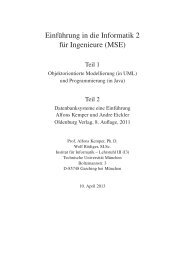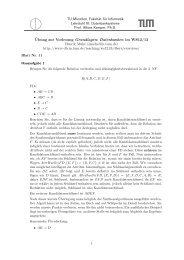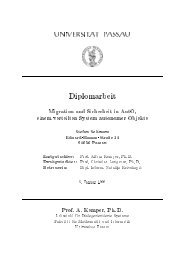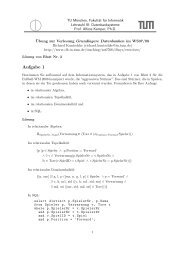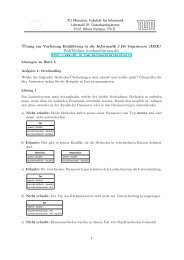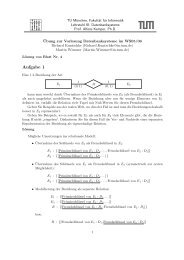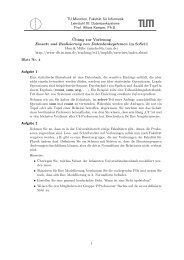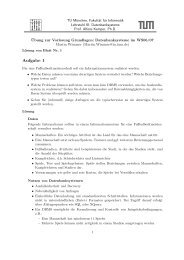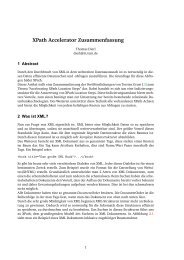The Adaptive Radix Tree: ARTful Indexing for Main-Memory ...
The Adaptive Radix Tree: ARTful Indexing for Main-Memory ...
The Adaptive Radix Tree: ARTful Indexing for Main-Memory ...
You also want an ePaper? Increase the reach of your titles
YUMPU automatically turns print PDFs into web optimized ePapers that Google loves.
<strong>The</strong>se data structures directly use the digital representation of<br />
keys instead of hashing or comparing keys. <strong>The</strong> underlying<br />
idea is similar to a thumb-index found in many alphabetically<br />
ordered dictionary books: <strong>The</strong> first character of a word can<br />
directly be used to jump to all words starting with that<br />
character. In a computer, this process can be repeated with<br />
the next characters until a match is found. As a consequence<br />
of this process, all operations have O(k) complexity where k is<br />
the length of the key. In the era of extremely large data sets,<br />
when n is growing faster than k, having a time complexity<br />
independent of n is very attractive.<br />
In this work, we present the adaptive radix tree (ART) which<br />
is a fast and space-efficient in-memory indexing structure<br />
specifically tuned <strong>for</strong> modern hardware. While most radix<br />
trees require to trade off tree height versus space efficiency<br />
by setting a globally valid fanout parameter, ART adapts the<br />
representation of every individual node, as exemplified in<br />
Figure 1. By adapting each inner node locally, it optimizes<br />
global space utilization and access efficiency at the same time.<br />
Nodes are represented using a small number of efficient and<br />
compact data structures, chosen dynamically depending on<br />
the number of child nodes. Two additional techniques, path<br />
compression and lazy expansion, allow ART to efficiently<br />
index long keys by collapsing nodes and thereby decreasing<br />
the tree height.<br />
A useful property of radix trees is that the order of the keys<br />
is not random as in hash tables; rather, the keys are ordered<br />
bitwise lexicographically. We show how typical data types can<br />
be reordered efficiently to support all operations that require<br />
the data to be ordered (e.g., range scan, prefix lookup, top-k,<br />
minimum, and maximum).<br />
This work makes the following contributions:<br />
• We develop the adaptive radix tree (ART), a fast and<br />
space-efficient general-purpose indexing structure <strong>for</strong><br />
main-memory database systems.<br />
• We prove that the space consumption per key is bounded<br />
to 52 bytes, even <strong>for</strong> arbitrarily long keys. We show<br />
experimentally, that the space consumption is much lower<br />
in practice, often as low as 8.1 bytes per key.<br />
• We describe how common built-in data types can be<br />
stored in radix trees while retaining their order.<br />
• We experimentally evaluate ART and other state of the<br />
art main-memory index structures, including the most<br />
efficient search tree proposals.<br />
• By integrating ART into the main-memory database<br />
system HyPer and running the TPC-C benchmark, we<br />
prove its superior end-to-end per<strong>for</strong>mance in a “real-life”<br />
transaction processing application.<br />
<strong>The</strong> rest of this paper is organized as follows. <strong>The</strong> next section<br />
discusses related work. Section III presents the adaptive<br />
radix tree and analyzes its space consumption. In Section IV<br />
we introduce the concept of binary-comparable keys and show<br />
how common built-in types can be trans<strong>for</strong>med. Section V<br />
describes experimental results including a number of micro<br />
benchmarks and the TPC-C benchmark. Finally, Section VI<br />
concludes and discusses future work.<br />
II. RELATED WORK<br />
In disk-based database systems, the B + -tree [8] is ubiquitous<br />
[9]. It retrieves large blocks from disk to reduce the<br />
number of accesses. Red-black trees [10], [11] and T-trees<br />
[4] were proposed <strong>for</strong> main-memory database systems. Rao<br />
and Ross [5] showed that T-trees, like all binary search trees,<br />
suffer from poor cache behavior and are there<strong>for</strong>e often slower<br />
than B + -trees on modern hardware. As an alternative, they<br />
proposed a cache conscious B + -tree variant, the CSB + -tree<br />
[12]. Further cache optimizations <strong>for</strong> B + -trees were surveyed<br />
by Graefe and Larson [13].<br />
Modern CPUs allow to per<strong>for</strong>m multiple comparisons with<br />
a single SIMD instruction. Schlegel et al. [6] proposed k-<br />
ary search which reduces the number of comparisons from<br />
log 2 n to log K n where K is the number of keys that fit<br />
into one SIMD vector. In comparison with binary trees, this<br />
technique also reduces the number of cache misses, because<br />
K comparisons are per<strong>for</strong>med <strong>for</strong> each cache line loaded<br />
from main memory. Kim et al. extended this research by<br />
proposing FAST, a methodology <strong>for</strong> laying out binary search<br />
trees in an architecture sensitive way [7]. SIMD, cache line,<br />
and page blocking are used to optimally use the available<br />
cache and memory bandwidth. Additionally, they proposed to<br />
interleave the stages of multiple queries in order to increase<br />
the throughput of their search algorithm. FAST trees and<br />
the k-ary search trees are pointer-free data structures which<br />
store all keys in a single array and use offset calculations<br />
to traverse the tree. While this representation is efficient and<br />
saves space, it also implies that no online updates are possible.<br />
Kim et al. also presented a GPU implementation of FAST and<br />
compared its per<strong>for</strong>mance to modern CPUs. <strong>The</strong>ir results show<br />
that, due to the higher memory bandwidth, GPUs can achieve<br />
higher throughput than CPUs. Nevertheless, the use of GPUs<br />
as dedicated indexing hardware is not yet practical because<br />
memory capacities of GPUs are limited, communications cost<br />
with main memory is high, and hundreds of parallel queries<br />
are needed to achieve high throughput. We, there<strong>for</strong>e focus on<br />
index structures <strong>for</strong> CPUs.<br />
<strong>The</strong> use of tries <strong>for</strong> indexing character strings has been<br />
studied extensively. <strong>The</strong> two earliest variants use lists [14]<br />
and arrays [15] as internal node representations. Morrison<br />
introduced path compression in order to store long strings<br />
efficiently [16]. Knuth [17] analyzes these early trie variants.<br />
<strong>The</strong> burst trie is a more recent proposal which uses trie nodes<br />
<strong>for</strong> the upper levels of the tree, but switches to a linked list<br />
once a subtree has only few elements. <strong>The</strong> HAT-trie [18]<br />
improves per<strong>for</strong>mance by replacing the linked list with a<br />
hash table. While most research focused on indexing character<br />
strings, our goal is to index other data types as well. <strong>The</strong>re<strong>for</strong>e,<br />
we prefer the term radix tree over trie because it underscores<br />
the similarity to the radix sort algorithm and emphasizes that<br />
arbitrary data can be indexed instead of only character strings.<br />
<strong>The</strong> Generalized Prefix <strong>Tree</strong> was proposed by Boehm et<br />
al. [19] as a general-purpose indexing structure. It is a radix<br />
tree with a fanout of 16 and was a finalist in the SIGMOD



